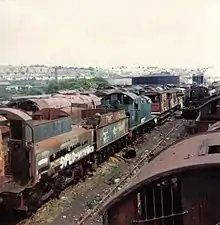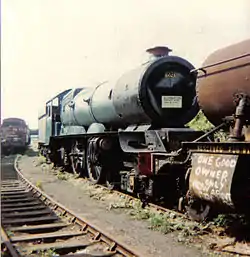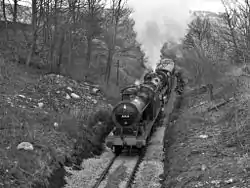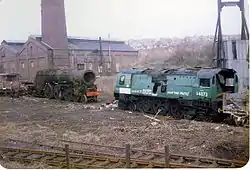Woodham Brothers
Woodham Brothers Ltd is a trading business, based mainly around activities and premises located within Barry Docks, in Barry, South Wales. It is noted globally for its 1960s activity as a scrapyard (hence its colloquial name of Barry Scrapyard), where 297 withdrawn British Railways steam locomotives were sent, from which 213 were rescued for the developing railway preservation movement.[1][2][3][4]
 Woodham Brothers scrapyard in 1982 | |
| Type | Private company |
|---|---|
| Industry | Scrap metal Commercial Property |
| Founded | 1892 (as Woodham & Sons) |
| Headquarters | , |
Key people | Dai Woodham (1919–1994) |
| Website | woodhambrosltd |

History
Established in 1892 as Woodham & Sons by Albert Woodham, the company was based at Thomson Street, Barry. The company bought old rope, dunnage wood and scrap metal from the ships, boats and marine businesses which used the newly created Barry Docks,[5] which it then resold or scrapped.
Albert retired in 1947, when his youngest son, Dai, was demobbed from the British Army after World War II. Dai renamed the business Woodham Brothers Ltd in 1953, creating four lines of business under four separate companies, which between them employed 200 people: Woodham Brothers, Woodham Transport, Woodham Marine and Woodham Metals.[5]
1955 Modernisation Plan/Beeching Report
As a result of the 1955 Modernisation Plan the decision was made by the British Railways Board in the late 1950s to:[6]
- accelerate the move to diesel- and electric-powered trains, consequently leading to the scrapping of 16,000 steam locomotives
- reduce the wagon fleet from 1¼ million to 600,000
The strategy chosen to replace the steam locomotive fleet initially involved the replacement of steam shunting and branch line locomotives with diesel-electric traction, and the movement of the replaced small steam locomotives to the major railway works for scrapping. In 1958 the British Transport Commission reappraised the speed of the programme, and the decision was taken to accelerate the disposal of the steam fleet.[6] Although the capacity of the locomotive works was considerable, as a result of the 1958 acceleration the amount of storage and technical scrapping capability of the works became stretched. The British Railways Board decided to out-source via tender to selected scrap merchants the work of scrapping the steam locomotives.[6]
Woodhams scrapyard
By the mid-1950s, Woodham Brothers was trading mainly as a scrap metal merchants, producing high quality scrap metal for the newly nationalised steel industry. Dai Woodham, as a result of the British Rail decision, negotiated a contract in 1957 to scrap metal mainly from the Western Region, covering like other scrap merchants the easily handled railway line and rolling stock;[5] the more complex steam locomotives were to be handled solely by the railway works. As none of the many South Wales-based scrap merchants knew how long the work from scrapping the short-wheelbase coal wagons from the former South Wales coalfield would last, they all chose to scrap these first.[6]
Each lot of metal was bought at an auction as a piece of rolling stock or infrastructure, with each lot having a priority for scrapping as detailed by British Railways. Woodham's premises which were based at Barry Docks, agreed an extended lease with the British Transport Docks Board, over the former marshalling yards of the almost redundant Barry Docks, close to what were the locomotives works of the former Barry Railway Company close to Barry Island. This allowed them to store large quantities of rolling stock that they had bought from British Railways, before they were scrapped.[5]
The 1958 decision resulted in Woodham Brothers winning a tender to scrap locomotives, and in 1959 Dai Woodham went to Swindon Works for a week to learn how to scrap steam locomotives: "It was a completely different job from what we were used to." On 25 March 1959, the first batch of engines was despatched from Swindon to Barry: GWR 2-6-0's numbers 5312/60/92/97 and a single 2-6-2T Prairie tank, 3170 a week later.[6]
However, on delivery of both scrap rail and rolling stock, Woodham's found that commercially it was easier to both comply with the contract terms and conditions and turn a profit if they concentrated on the easier to scrap rail profile and rolling stock. There was also at least ten times the volume of wagons, which took up more space and reduced Woodham's capacity to bid on more contracts. Hence it was agreed internally to leave the more difficult locomotives until later, perhaps picking up the work when the volume of rolling stock and railway line abated.[5]
From mid-1964, Woodham Brothers won additional contracts to scrap Southern Region stock, and as a result expanded their Barry Docks yard leases to cover more of the former marshalling yards. In 1965, 65 locomotives had arrived at the scrapyard, of which 28 were scrapped, but the additional volume of Southern rail, wagons and brake vans meant that the autumn of 1965 was the last year that mass-scrapping of steam locomotives occurred at Woodham Brothers.[6] Dai Woodham continued to purchase steam locomotives until the end of steam, bringing total purchases by August 1968 to 297 locomotives, of which 217 then remained at the Barry scrapyard.[6]
Preservation centre

The rows of redundant steam locomotives were a picturesque sight for holidaymakers travelling to Barry Island, and became a centre for pilgrimage for steam enthusiasts from the emerging steam railway preservation movement.
While there was still a significant number of steam locomotives in the yard, railway preservationists began buying the better examples from the late 1960s in order to restore them to working order. The first locomotive to be the subject of a rescue appeal was GWR 4300 Class 5322, which eventually did leave Barry in March 1969, becoming the third locomotive to leave,[7] but the first to be bought and actually moved from the yard was Midland Railway 3835 Class No. 43924 in September 1968. The engine was taken on by the 4F Locomotive Society, and the engine now resides at the Worth Valley Railway.[8]
However, this did not stop the engines from being scrapped as a whole, as in 1972, 4MT Mogul No. 76080 was cut up and the following year, 2884 class No. 3817 was cut up as well.[9]
Under the terms of the contract from British Rail, Woodhams could not sell complete locomotives onwards that had been sold to them for scrap, unless payment of a levy was made. Woodham's set the price for each locomotive at its exact scrap value (each type had an exact metal content breakdown from BR, so this was simply taken and multiplied by that day's scrap rate for each metal component), plus the BR levy; with the sale price completed by the addition of Value Added Tax, initially set at 10% but raised to 15% in 1979.[8] For most of the time that locomotives were being 'rescued' from Barry, it became accepted commercial practice by the company for preservation groups to pay a deposit for a particular locomotive, which was then protected/reserved until the group could pay for the locomotive in full and arrange transport.[8]
Initially, locomotives were both mostly complete and able to move easily, although British Rail only allowed them to be towed by one of their own diesels, accompanied by a brake van to act as extra braking. Purchased locomotives were hence moved to a holding siding, inspected by British Rail, and then attached to a special train direct to the purchaser's site. However, after some minor incidents involving overheated axle boxes due to a lack of lubrication, BR banned movement by rail from 1976, and all locomotives were thereafter transported out by road to the M4 motorway.[10]
The movement of locomotives to the holding sidings for inspection was also an issue, due to the deteriorating condition of the track in Woodham's yard. With the need to occasionally move locomotives in order to retrieve another which had been purchased for preservation, derailments would sometimes occur due to the poor state of the track. As Woodham's lacked the necessary equipment to re-rail the locomotives, it was easier to simply cut part of the derailed wheelset away, allowing the movement of the affected locomotive to continue.[10] During this period, Woodham's also began scrapping locomotive tenders with the intention of then re-selling the rolling tender frames to other users. The majority of these frames were purchased by the Duport Steelworks at Briton Ferry for conversion to ingot carriers.[11]
From the start of locomotive preservation, owners were allowed to remove components from similar types of locomotives to make up a complete kit of bits, on the condition that the donor locomotive was not reserved and that no substantial damage was incurred in removing the parts. However, this policy combined with ease of access to the extensive yards resulted in petty pilfering and trophy/memorabilia collection in the early years, to mass criminal activity. Although Woodham's had allowed weekend working parties to access reserved locomotives, by 1981 illegal removal of valuable scrap had got so bad that Woodham's employed a 24-hour security guard team, and a total ban was placed on weekend working parties.[8]
Barry Steam Locomotive Action Group
As the number of locomotives dropped below 100, the number of wagons coming for scrap also slowed, making it more likely that Woodham's would return to scrapping steam locomotives. Following a meeting of interested parties on 10 February 1979 the Barry Steam Locomotive Action Group was formed with the aim of putting potential purchasers and Woodham Brothers together, as well as funders and financial contributors. BSLAG undertook basic surveys of the remaining locomotives, listing types and conditions and acting as a media liaison point.
However, during the summer of 1980 BR were unable to offer any quantity of redundant wagons to Woodham's for scrap. Rather than lay off staff, Dai Woodham authorized the scrapping of two steam locomotives, BR Standard Class 9F No. 92085, and GWR 5101 Class No. 4156. By August, more former steel coal wagons had been delivered to the yard, making 4156 and 92085 the last locomotives to be broken up at Barry.[8]
Locomotives scrapped at Woodham Brothers scrapyard
While most steam locomotives made it out of Barry Scrapyard,[12] some were scrapped from 1958 to 1980[13][14] and all of the diesel engines that entered the yard were scrapped, despite some being subject to preservation attempts.[15]
- 2 × GWR 1366 Class
- 1367, 1368
- 1 × GWR 1400 Class
- [16] 1428
- 1 × GWR 2884 Class
- 3817 (scrapped 1973)
- 1 × GWR 3150 Class
- 3170
- 8 × GWR 4300 Class
- 5312, 5345, 5355, 5360, 5392, 5397, 6331, 6334
- 2 × GWR 4500 Class
- 4550, 4559
- 8 × GWR 4575 Class
- 4594, 5504, 5510, 5514, 5546, 5547, 5557, 5558
- 4 × GWR 5101 Class
- 4156 (scrapped 1980), 4157, 4164, 5182
- 3 × GWR 5400 Class
- 5407, 5417, 5422
- 4 × GWR 5600 Class
- 5651, 5669, 6621, 6696
- 12 × GWR 5700 Class
- 3727, 3794, 5794, 6753, 7702, 7712, 7719, 7722, 7723, 7725, 7758, 8749
- 1 × GWR 6100 Class
- 6115
- 1 × GWR 6400 Class
- 6406
- 1 × GWR 7200 Class
- 7226
- 17 × GWR 9400 Class
- 8419, 8473, 8475, 8479, 9436, 9438, 9439, 9443, 9445, 9449, 9459, 9462, 9468, 9491, 9492, 9496, 9499
- 7 × Hunslet Austerity 0-6-0ST
- [17][18] 106/75040 Spyck, 108, 119, 130, 164, 178/75277 Foligno, 203
- 2 × LSWR Class S15
- 30512, 30844
- 2 × SR West Country and Battle of Britain classes
- 34045 Ottery St Mary, 34094 Mortehoe
- 2 × LMS Ivatt Class 2 2-6-2T
- 41248, 41303
- 1 × BR Standard Class 4 2-6-0
- 76080 (scrapped 1972)
- 1 × BR Standard Class 4 2-6-4T
- 80067
- 2 × BR Standard Class 9F
- 92085 (scrapped 1980), 92232
- 1 × British Rail Class 15
- [19] D8206
- 1 × British Rail Class 21 (NBL)
- [19] D6122 (scrapped 1980)
Today

at Woodham's Scrapyard, Barry in 1984
In the early 1970s, Dai Woodham started building what are now called the Romily Units at the Woodham Road site on No.2 Dock, Barry Docks, for the purpose of giving local business-people access to cheap industrial units. By 1987 he had managed to build up the site to contain 23 industrial units to rent, ranging in size from to 2,488 to 4,145 sq ft (231.1 to 385.1 m2), with access to the docks, the railway and the M4 motorway. The main Woodham Brothers business is today based around these industrial units.[5]
Woodham Brothers continued dealing as scrap metal merchants, and continued scrapping locomotives on behalf of British Railways. Casualties included some of the earlier types of diesels ahead of the remaining steam locomotive stock. British Rail Class 21 No. D6122 was the last of its class to survive, arriving in August 1968 and cut up by Woodhams in 1980 because no one wanted to buy it.
After Dai Woodham announced that he was going to retire, a concerted effort was made to clear the remaining hulks. One result of this was that ten locomotives, known as the Barry Ten, were taken on by the Vale of Glamorgan Council and stored in 'scrapyard' condition. All under the care of the Barry Tourist Railway, eight locomotives are still in Barry only a few hundred yards away from where they were removed, while two are under restoration at different locations around the country. GWR 4575 Class No. 5553 was the last steam engine to leave Woodham Brothers, in January 1990 for the West Somerset Railway.
A total of 213 locomotives were 'rescued' from Woodham's yard and many have been restored. By 2019, 150 ex-Barry locomotives had been restored to working order (the 150th being GWR 4-6-0 No. 6989 Wightwick Hall[22]), although many of these have since been withdrawn for overhaul and are out of use or awaiting further work.
In popular culture
On their 2008 debut album, London band Silvery released "Warship Class", a song about a childhood trip to the scrapyard in search of the remaining British Rail Class 41 (Warship Class) locomotive - D601 - 'Ark Royal'.[23]
One of the engines rescued, and arguably the most famous one of them all, from Barry Scrapyard GWR 4900 Class No. 5972 Olton Hall which was rescued in 1981 became a pop culture icon in the 2000s for being a part of the Harry Potter films.[24][25][26][27][28][29][30][31]
Several books have been published about the area, its history, and Dai Woodham's work in railway preservation.[32][33][34]
Locomotives saved from Woodham Brothers scrapyard
For the full list, see the article List of locomotives saved from Woodham Brothers scrapyard.
References
- Harris, Sharon. "Book details fascination with Barry and its steam locomotives". Barry & District News. Retrieved 25 January 2011.
- Owens, David. "The 'locomotives graveyard' where hundreds of old engines were saved from the scrapheap". Wales Online. Wales Media Ltd. Retrieved 15 July 2018.
- Carradice, Phil. "The Barry railway scrapyard". BBC Blogs. BBC. Retrieved 18 July 2013.
- Lloyd, Matt. "How the Hogwarts Express was saved from a Welsh scrapyard". BBC News. Retrieved 31 August 2018.
- "History of the Business". Woodham Brothers. Archived from the original on 27 July 2009. Retrieved 19 October 2008.
- "The Barry Scrapyard story, part 1". The Great Western Archive. Retrieved 19 October 2008.
- Chatman, Peter. "5322 – A VENERABLE LOCOMOTIVE - BY PETER CHATMAN". Didcot Railway Centre. Great Western Society Limited. Retrieved 15 November 2020.
- "The Barry Scrapyard story, part 2". The Great Western Archive. Retrieved 19 October 2008.
- "Locomotives scrapped at Barry, 1959 - 1980". The Great Western Archive.
- "The Barry Scrapyard story, part 3". The Great Western Archive. Retrieved 19 October 2008.
- Beck, Nick; Salmon, Richard (27 December 2018). "British Railways Standard Class 2MT 2-6-2 Tank Locomotive No 84030". Bluebell Railway.
- "Locomotives Saved from Woodham Brother's Scrapyard, Barry, South Wales". Rail UK: The Premier UK Rail History Site. Database Facilites [sic] by Milburn Associates. Retrieved 1 November 2020.
- "Locomotive Scrapyard". Rail UK: The Premier UK Rail History Site. Database Facilites [sic] by Milburn Associates. Retrieved 1 November 2020.
- Daniel, John. "Locomotives scrapped at Barry, 1959 - 1980". The Great Western Archive. Retrieved 26 May 2013.
- "The Barry Graveyard". My Wales. WordPress.com. Retrieved 14 August 2018.
- "1428". Rail UK: The Premier UK Rail History Site. Database Facilites [sic] by Milburn Associates. Retrieved 1 November 2020.
- Hands, Peter. "FROM THE SPOTTING NOTES OF PETER HANDS – SOUTH WALES FIFTY TWO YEARS AGO ON THIS DATE 22.3.1964". What Happened To Steam. What Happened To Steam. Retrieved 4 October 2017.
- Green, Steve (February 2011). "The Marchwood Military Railway" (PDF) (61). WIMBORNE RAILWAY SOCIETY. THE CORKSCREW 2001 - 2011 Newsletter of the WIMBORNE RAILWAY SOCIETY. Retrieved 1 November 2020.
- Alexander, Colin (15 May 2017). The British Railways Pilot Scheme Diesel Locomotives. Stroud, Gloucestershire, Wales: Amberley Publishing. ISBN 9781445665573. Retrieved 1 November 2020.
- Daniel, John. "D600 'Warship' class introduction". The Western Region Archive. Retrieved 16 April 2013.
- "DIAMONDS WERE FOREVER". RAILWAY MATTERS ON TRACK. Retrieved 4 June 2020.
- Devereux, Nigel. "Wightwick Hall becomes 150th Barry Scrapyard restoration". The Railway Hub. Mortons Media Group Ltd. Retrieved 31 December 2018.
- "Warship Class". The Quaire Fellow. 2 January 2011. Archived from the original on 4 March 2016 – via Blogspot.com.
- "All aboard the Hogwarts Castle for Harry Potter fans". Costwold Journal. Newsquest Media Group Ltd. Retrieved 19 May 2009.
- "Vandals attack Harry Potter train". BBC News. Retrieved 4 September 2003.
- Errico, Marcus. "Harry's Hogwarts Express Vandalized". EOnline. NBC Universial. Retrieved 4 September 2003.
- Wood, Matthew. "Harry Potter's Hogwarts Express Was Originally Set To Be Scrapped". Cinema Blend. Retrieved 1 September 2019.
- Bartsch, Eric. "Harry Potter's Hogwarts Express Was Once Headed to the Scrap Heap". Comic Book Resources. Retrieved 2 September 2018.
- Keller, Bob. "Lionel's O gauge Hogwarts Express Train Set". Classic Toy Trains. Kalmbach Media. Retrieved 4 September 2007.
- Hewitt, Sam. "How These Five Locomotives Changed the World". The Railway Hub. Mortons Media Group Ltd. Retrieved 18 September 2019.
- Jones, Robin (2019). Legendary Locomotives. Mortons Media Group Ltd. p. 132. ISBN 978-1-911276-90-6. Retrieved 2 November 2020.
- Brabham, Peter (7 February 2013). Barry: The History of the Yard and Its Locomotives Hardcover. Crecy Publishing. p. 256. ISBN 978-0860936435. Retrieved 8 November 2020.
- Platt, Keith W. (15 October 2017). Barry Scrapyard. Amberley Publishing. p. 96. ISBN 9781445670775. Retrieved 8 November 2020.
- Hodge, John (30 July 2018). Barry, Its Railway and Port Before and After Woodham's Scrapyard. Pen & Sword Books. p. 200. ISBN 9781526723840. Retrieved 8 November 2020.
- Hardingham, Roger. The Story of Barry.
- Hardingham, Roger. The Barry List. (There are at least 8 editions of this booklet: the 8th edition lists all those rescued from the scrap heap.)
- Whittaker, Nicholas (1995). "Chapter 11". Platform Souls. London: Gollancz.
External links
| Wikimedia Commons has media related to Woodhams' scrapyard. |